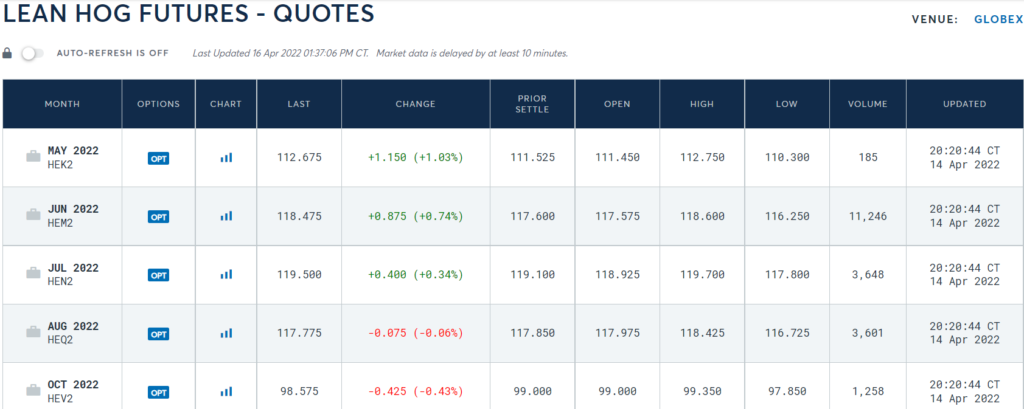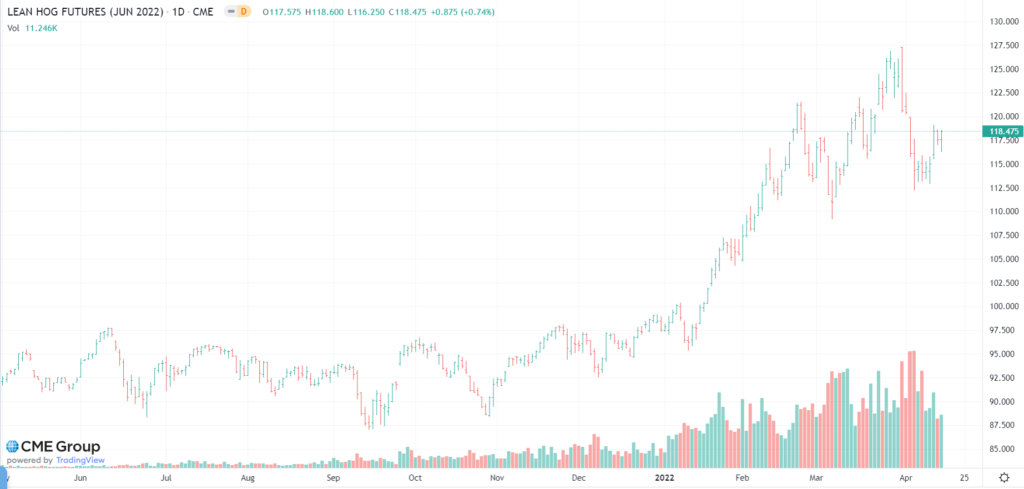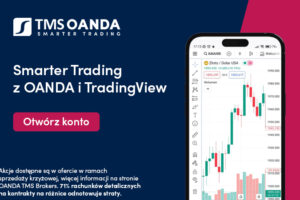Lean Hog contracts - how to invest in pigs [Guide]
Lean hog contracts are not a very popular instrument among retail investors, but they play a significant role in managing the risk of parts of the agricultural industry in the United States. What does trading on these contracts look like and how can you invest in them? This is what we will check in this article.
According to the National Pork Producers Council, the pig farming, slaughter and processing industry alone translates into $ 39 billion in GDP annually. There are 60 companies operating in this market which raise 000 million pigs each year. In the US alone, the industry's annual production was over 115 billion pounds (28,3 million tonnes). Not all production goes to the domestic market. In 12,8, the main directions of American pork exports were China (28% of exports), Meksyk (22%) and Japan (16%). Lean hog futures were introduced in 1966. The trading venue for this contract is CME (Chicago Mercantile Exchange). Investing in pigs can be done through lean hog contracts. Sometimes, and Forex brokers offer CFDs based on these instruments, but we will come back to that later.
READ: How to invest in food? ETN, ETF, REIT [Guide]
Pig contracts: specification
Every lean hog futures it says about pork weighing 40 poundswhich is approximately 18 tons. Contracts are settled in US dollars, a the minimum tick is worth $ 10. Futures contracts are settled in the following months:
- February,
- April,
- May,
- June,
- July,
- August,
- October,
- December.
Contracts are settled in cash. It is therefore a different type of settlement than is the case with live cattle contracts, where the expiry of the contract is associated with the delivery / receipt of goods, and in the event of problems - a financial penalty.
Lean Hog Futures: Turnover
Looking at the turnover on the live cattle futures market, it can be seen that most of the turnover is focused on the June, July and August series.
As you can see in the chart below, there is a trace of trading in series with a very long time-to-expiry. It grows with the approach of the contract implementation period. However, when there is little time until the contract expires, there is a slow decline in trading due to contract rollover. In such a situation, speculators switch to longer-term contracts.
Speculation and headging on lean hog contracts
Futures market participants can be divided into two types: speculators and using futures contracts to reduce risk. Speculators are those market participants who try to predict the direction in which futures contract prices will go. This type of market participant is needed in the futures market because it provides liquidity in the market.
The second group are the so-called hedger's, i.e. market participants who use futures contracts to hedge their position. One of the basic solutions is the use of the so-called "Lock-in", or securing the sale or purchase price in the future. This reduces the risk of doing business, but at the cost of exposing yourself to the risk of selling pork too cheap or buying it at a much higher price than the market price.
Hedging and business risk
The pork farmer has to bear the costs of feed, labor and livestock keeping, but there is no certainty about selling prices. This creates a risk that breeding, as a result of falling prices, will be more expensive than the market price. To remedy this, lean hog futures contracts can be used.
Pork futures can also be used as part of a hedging transaction. The purchase of lean hog futures contracts is used by slaughterhouses or meat processing plants, which secure their raw material costs. Buying futures means that the holder of the long position is committed to buying the pork at a predetermined price. Thanks to this, in the event of an increase in the forward price, the holder of the long position earns a profit on the futures contract. This allows for the costs of rising prices on the spot market to be covered. As a result, processing plants and slaughterhouses can have higher profitability than competitors that do not use a hedging transaction. In the event of a drop in prices on the futures market, the owner of a long position generates a loss, and therefore does not benefit from the sell-off on the spot market.
The sale of lean hog futures contracts is another example of a hedging transaction. In such a situation, the holder of the short commits to selling the pork at a predetermined price. It is therefore a good solution for a pig farmer who wants to sell his product to a slaughterhouse but is concerned about the market price in a few months. Thanks to this, he can more accurately estimate the profitability of his breeding. If the pork market price increases, the breeder will suffer a loss on the hedging transaction after closing the hedging transaction. In the event that the pork price drops, the farmer will cover the loss on the spot market through the profit of the hedging transaction.
How to Invest in Lean Hogs (Pig) - CFD Brokers
A more affordable alternative for individual investors, whose aim is only to speculate on these types of instruments, are CFDs available from Forex brokers. By using CFDs, traders primarily "gain" much lower margin requirements when opening a position and often a more flexible transaction volume as well.
Below is a list of offers from selected brokers offering favorable conditions for trading on lean hogs (CFD) instruments.
| Broker |  |
 |
 |
| End | Poland | Cyprus * | Denmark |
| Lean Hog symbol | LEANHOGS | HE / Pork carcasses | LEANHOGS |
| Min. Deposit | PLN 0 (recommended min. PLN 2000 or USD 500, EUR) |
PLN 500 | PLN 0 / EUR 0 / USD 0 |
| Min. Lot value | price * 400 USD | - | b / d |
| Commission | - | - | - |
| Platform | xStation | Plus500 platform | SaxoTrader Pro Saxo Trader Go |
* PLUS500 CY offer
CFDs are complex instruments and come with a high risk of losing money rapidly due to leverage. From 72% to 89% of retail investor accounts record monetary losses as a result of trading CFDs. Think about whether you understand how CFDs work and whether you can afford the high risk of losing your money.






















![Forex Club – Tax 9 – Settle tax on a foreign broker [Download the Application] Forex Club - Tax 9](https://forexclub.pl/wp-content/uploads/2024/02/Forex-Club-Podatek-9-184x120.jpg?v=1709046278)
![Trading View platform – solutions tailored to the needs of traders [Review] trading view review](https://forexclub.pl/wp-content/uploads/2024/03/trading-view-recenzja-184x120.jpg?v=1709558918)
![How to connect your FP Markets account to the Trading View platform [Guide] fp markets trading view](https://forexclub.pl/wp-content/uploads/2024/02/fp-markets-trading-view-184x120.jpg?v=1708677291)
![How to invest in ChatGPT and AI? Stocks and ETFs [Guide] how to invest in chatgpt and artificial intelligence](https://forexclub.pl/wp-content/uploads/2023/02/jak-inwestowac-w-chatgpt-i-sztuczna-inteligencje-184x120.jpg?v=1676364263)


![WeWork – the anatomy of the collapse of a company valued at $47 billion [WeWork, part II] wework bankruptcy story](https://forexclub.pl/wp-content/uploads/2024/04/wework-bankructwo-historia-184x120.jpg?v=1711729561)
![Adam Neumann – the man who screwed up Softbank [WeWork, part AND] adam neumann wework](https://forexclub.pl/wp-content/uploads/2024/04/adam-neumann-wework-184x120.jpg?v=1711728724)





![How to transfer shares to another brokerage office [Procedure description] how to transfer shares to another brokerage house](https://forexclub.pl/wp-content/uploads/2024/03/jak-przeniesc-akcje-do-innego-biura-maklerskiego-184x120.jpg?v=1709556924)

![The most common mistakes of a beginner trader - Mr Yogi [VIDEO] Scalping - The most common mistakes of a beginner trader - VIDEO](https://forexclub.pl/wp-content/uploads/2024/03/Scalping-Najczestsze-bledy-poczatkujacego-tradera-VIDEO-184x120.jpg?v=1711601376)
![Learning patience: No position is also a position - Mr Yogi [VIDEO] Scalping - Learning patience - No position is also a position - VIDEO](https://forexclub.pl/wp-content/uploads/2024/03/Scalping-Nauka-cierpliwosci-Brak-pozycji-to-tez-pozycja-VIDEO-184x120.jpg?v=1710999249)
![When to exit a position and how to minimize losses - Mr Yogi [VIDEO] Scalping - When to exit a position and how to minimize losses - VIDEO](https://forexclub.pl/wp-content/uploads/2024/03/Scalping-Kiedy-wyjsc-z-pozycji-i-jak-minimalizowac-straty-VIDEO-184x120.jpg?v=1710336731)



![Lean Hog contracts - how to invest in pigs [Guide] lean hog contracts](https://forexclub.pl/wp-content/uploads/2022/04/kontrakty-lean-hog.jpg?v=1650448089)





![Lean Hog contracts - how to invest in pigs [Guide] Used cars](https://forexclub.pl/wp-content/uploads/2022/04/uzywane-samochody-102x65.jpg?v=1650443270)
![Lean Hog contracts - how to invest in pigs [Guide] bitcoin farms china](https://forexclub.pl/wp-content/uploads/2021/06/farmy-bitcoina-chiny-102x65.jpg?v=1624438825)










Leave a Response